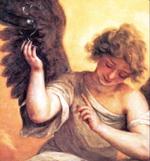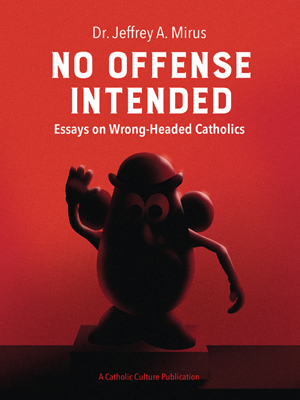John Duns Scotus: Champion of the Immaculate Conception
by Brother John M. Samaha, S.M.
The year 2004 marks the sesquicentennial of the dogmatic definition of the Immaculate Conception of Mary by Blessed Pope Pius IX in 1854. To celebrate the centenary of the infallible proclamation of this dogma of faith, Pope Pius XII, a great apostle of Mary, declared 1954 a Marian Year; the first.
In 1858 Our Lady appeared to St. Bernadette Soubirous at Lourdes, France. When Bernadette asked the beautiful lady who she is, Mary identified herself in these words: "I am the Immaculate Conception." This happened four short years after the solemn definition. For the centenary of that miraculous even, the Marian-minded Pope Pius XII pronounced 1958 the Lourdes Year.
Though belief in Mary's Immaculate Conception never wavered among the truly faithful, for centuries theologians were at a loss to explain adequately and with satisfactory doctrinal clarity this privilege accorded the Mother of Christ. Then in "the greatest of centuries" a humble and brilliant friar brought resolution to this knotty question: how was Mary, who was like all human beings in need of redemption, conceived without sin?
To the keen and penetrating mind of the thirteenth century Franciscan philosopher and theologian, Blessed John Duns Scotus, all Christendom owes respect and honor. For it was Duns Scotus who plodded carefully through the maze of theological reasonings to explain clearly Mary's Immaculate Conception. His study and consideration of the disputed questions regarding Mary's conception without sin dissipated the obstacles to a complete understanding of this privilege and laid a solid foundation for the definition of this dogma.
Very little is known about the early life and family background of John Duns Scotus. Scotland was his birthplace in the year 1266. Scotus was a surname given in those days to Scots, North Englanders, and Irish. Duns was most likely his family name.
After some schooling he joined the Franciscans about 1290. As a young Franciscan he both studied and taught at Oxford, distinguishing himself in each position. After several years of teaching at Oxford, Duns Scotus left for Paris probably in 1304, there to lecture in the famed University of Paris. Holding only a bachelor's degree from Oxford, he taught admirably.
While in Paris he was presented for the doctor's degree. In his letter of recommendation the Franciscan superior general commended him as a scholar "distinguished for his ingenious and very subtle learning." Following a brief stay at Paris the youthful doctor of theology took up teaching duties at Cologne. Here he died unexpectedly in November 1308.
John Duns Scotus is commonly known as Doctor Subtilis, the Subtle Doctor, in theological and philosophical circles. This title developed out of the clever and ingenious character of his lecturing and writing.
The Subtle Doctor is justly regarded as one of the bright lights of theology in that brilliant era of scholarship that was the thirteenth century. Intellectual giants like St. Thomas Aquinas, St. Bonaventure, and St. Albert the Great preceded him by only a brief span of time.
During his comparatively short life Blessed John Duns Scotus produced numerous valuable writings. The majority of these written works are commentaries or treatises on disputed questions, for he was recognized as a heated controversialist — incisive in his criticism, relentless in his logic, decisive in his refutation, seemingly more adept in analyzing than in synthesizing. He left no summa or compendium of any kind.
Probably his greatest work is the Opus Oxoniensis, a sparkling commentary on the famous Sentences of Peter Lombard. The Opus Oxoniensis is noted for its orderliness and its wealth of detail. Up to the close of the thirteenth century Peter Lombard's Sentences were accepted as the basic theological reference, as later students took to the Summa Theologica of St. Thomas Aquinas.
The writings of Duns Scotus are not characterized by the clarity of St. Thomas Aquinas. Scotus's works are usually appraised as abstruse, critical writings couched in language that is obscure. His critics, of whom there are many, sometimes accuse him of leaning toward extremes, of dwelling on technicalities, and of being given to hair-splitting. But not all the writings that have borne his name are from his pen.
Duns Scotus's followers made additions and attached comments when gathering his works for publication some years after his death. Many incorrect and unfair notions have been circulated about the Subtle Doctor. Some of these mistaken opinions have not been challenged. Some of the unfavorable criticism may be attributed to the shortcomings of his followers. Part may have been caused by a lack of penetrating powers similar to those of Duns Scotus in the persons who appointed themselves as critics.
Since the sixteenth century a Scotist school of thought has continued to study, develop, and advocate the teaching of John Duns Scotus. The chief representatives of the Scotist school have been his brothers in religion, the Franciscans.
If the Subtle Doctor did no more than untangle the puzzling elements of Mary's Immaculate Conception, the Church would be indebted to him forever. Precisely for this accomplishment we remember John Duns Scotus.
In the attempt to unravel the theological puzzle, two difficulties had blocked the mental path to a complete understanding of our Blessed Mother's conception without sin.
First, was Mary in need of redemption if she had been conceived without stain of original sin?
Second, when, in the course of her conception, was Mary preserved from the stain and effects of original sin?
These obstacles had stymied many of the Church's leading theologians over the centuries — among them St. Augustine, St. Bernard, St. Anselm, St. Thomas Aquinas, and St. Bonaventure. So the great teachers of the Church hesitated to proclaim the doctrine of the Immaculate Conception.
Meanwhile, popular belief shifted toward the acceptance of this special prerogative for the Mother of Christ. The feast of the Immaculate Conception was instituted in many parts of Europe, although it was already celebrated in the East since the seventh century.
Enter Duns Scotus into the academic arena of the controversy. Beginning with the general principle formulated by St. Anselm in the eleventh century, potuit, decuit, ergo fecit (it was possible, it was fitting, therefore it was accomplished), he jumped into the thick of the intellectual tussle. In a matter of time the Subtle Doctor dispelled all objections satisfactorily.
The first hurdle in the dispute regarded Mary's need of redemption. If she was conceived in the womb of her mother, St. Anne, without original sin, was she exempt from Christ's redemption? Did she not need to be redeemed?
In his Letter to the Romans (5:12), St. Paul had taught "it was through on man (Adam) that sin came into the world, and through sin death, and thus death has spread through the whole human race because everyone has sinned." Paul is telling us that everyone inherits original sin and its consequences. Therefore Mary needed to be redeemed. But Christ had not yet come to accomplish the redemption.
Duns Scotus pushed this obstruction from the path by showing that instead of being excluded from the redemption of the Savior, Mary obtained the greatest of redemptions through the mystery of her preservation from all sin. This, explained Scotus, was a more perfect redemption and attributes to Christ a more exalted role as Redeemer, because redeeming grace, which preserves from original sin, is greater than that which purifies from sin already incurred.
Consequently, Christ was Mary's Redeemer more perfectly by preservative redemption in shielding her from original sin through anticipating and foreseeing the merits of his passion and death. This preredemption indicates a much greater grace and more perfect salvation.
Since Mary was a daughter of Adam, when was she preserved from original sin and its consequences? Here was another obstacle to be cleared. In resolving this second problem the Subtle Doctor cleverly saw his way clear by making the necessary distinction between the order of nature and the order of time.
Previously St. Thomas and other illustrious doctors of the Church had reasoned that Mary was sanctified and preserved from sin either before animation, that is, before God infused a soul into the physical embryo in her mother's womb, or after animation. She could not have been sanctified before animation; otherwise she would not have had to be redeemed. If Mary was sanctified after animation, then she whom God was raising to be Satan's destroyer, was, at least for a very brief time, subject to the influence of the Prince of Darkness through contact with original sin. This line of reasoning was based on a time sequence.
Blessed John Duns Scotus explained that the time element was not the type of order in question, but rather the order of nature. Because physical generation precedes sanctification by God's grace, Mary was an heir to the debt of Adam before being made a child of God. In our thinking we consider Mary first as a daughter of Adam and then sanctified as a daughter of God. But this does not necessarily place the soul of our Blessed Mother in two successive states — sin followed by grace. With Mary conception and sanctification were simultaneous, producing a twofold situation at the first moment of existence.
At one and the same time Mary, as a human descendant of Adam and Eve, contracted the debt of original sin and became by the privileged infusion of grace a daughter of God, which preserved her from the consequences of the common lot of fallen nature by a special anticipation of the anticipated merits of the Savior.
Removing these two impediments John Duns Scotus cleared the path to a theologically sound acceptance of this Marian prerogative. By his lucid exposition and defense of the doctrine of Mary's Immaculate Conception in the womb of St. Anne as a preparation for her divine motherhood, the Subtle Doctor paved the way for its solemn definition in the later times by Blessed Pope Pius IX.
Catholicism will remember the Subtle Doctor as a shrewd philosopher and an adroit theologian, one of the most eminent of that remarkable thirteenth century. To the ordinary Catholic, John Duns Scotus stands out as the champion of Mary's Immaculate Conception. In praising the Immaculate Conception, we also honor Blessed John Duns Scotus.
Brother John M. Samaha, S.M., belongs to the Pacific Province of the Marianists, and is currently working at Villa St. Joseph in Cupertino, Calif. Previously he was engaged in high school and adult education in the western states and Lebanon. He is a member and officer of the Mariological Society of America. His last article in HPR appeared in March 2000.
© 2003 Ignatius Press
This item 5825 digitally provided courtesy of CatholicCulture.org






